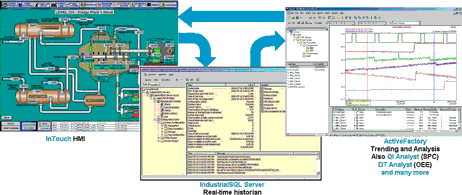
In September 2007, InTouch v10 will be released. It boasts many new features and capabilities. InTouch has a legacy of looking after the past while venturing into the future to meet market demands. More than ever, in an increasingly complex industrial world, it is living up to its name by keeping users InTouch with their past, present and future realities.
It is fitting that in the year that Wonderware celebrates its 20th anniversary, version 10 of InTouch, the company's first industrial automation product, is released. The new version is a far cry from the original product, which, for two decades has offered users easy upgrades towards improved functionality while looking after their existing engineering efforts.

Wonderware claims to be the most widely used HMI product in the world and, through its evolution, it has become a source of key information for its many users.
The HMI market today
According to a study done by the ARC Advisory Group in 2006, there are numerous changes taking place in the HMI software market. One of the key manufacturing trends that they see is that users of factory automation and enterprise computing solutions are placing a higher value on the information provided by the asset, rather than on the asset itself. HMI software plays a key role in the way an asset's information is viewed and analysed.
ARC predicts that the compound annual growth rate (CAGR) of the worldwide HMI software market through to 2010 will be approximately 9,3%.
InTouch users
Since the release of the ArchestrA-based Industrial Application Server (IAS) many InTouch users have wondered what the future holds for their InTouch investment. ArchestrA and the IAS were launched in 2003 and since then, InTouch users have seen new and significant releases. Far from being sidelined, InTouch has assumed an increasingly pivotal role in providing clear insights, not only into process control, but also into production performance and asset utilisation through its ability to overlay information from other applications to provide a single, cohesive and composite view of operational status and critical success factors.
There are the InTouch users who do not see the need for this extra sophistication and who are quite happy using InTouch as the effective HMI they know it to be - yet who feel that they will be left behind if they do not upgrade. The old adage is: form follows function. InTouch was designed to be an excellent HMI and the majority of the industrial world attests to that. However, as customer demands have grown over the years, InTouch has been expanded to meet them. But an HMI cannot do it all. InTouch is one component in a comprehensive suite of solutions based on an architecture designed to hold it all together (ArchestrA).
New features
InTouch v10 offers new ArchestrA graphics based on the latest Microsoft graphics technology. The new graphics editor provides the advanced drawing, shading and dynamic behaviour one would expect from a modern graphical application. Attention was also paid to the performance of the graphics with the result that displays with many complex animations have little effect on CPU loading.
The new version was also designed to cut engineering time and cost through such features as:
* Central management of All ArchestrA graphics symbols. Graphic symbols standards can be edited and all applications updated from a central point.
* Central management of system status indication such as PLC communication status provides consistent implementation across all applications and removes the need to engineer this for each graphic used in the HMI.
* Central management of applications. Updates can be managed centrally and deployed to remote InTouch stations. The InTouch applications also reside in a central Microsoft SQL database (Galaxy Repository), which simplifies backup and application source management.
* Tighter integration with Microsoft. InTouch and other Wonderware applications are evolving with Microsoft as more enabling technologies become available. Examples of these technologies include: MS Reporting Services, MS SharePoint, MS .NET 3.0 and MS BizTalk (OEM with WEI). InTouch is now a .NET container allowing for the display of components from modern applications. And all this falls under the 30-day MS Patch Support umbrella.
While form has resulted in powerful graphics, function addresses the engineering and business needs of end-users and system integrators. But that does not mean users have to use all this new functionality compulsively. They can continue to use InTouch the way they see fit with the certain knowledge that a painless and cost-effective migration path exists to increasing levels of sophistication as and when required.
Hardware bundling
Another example of 'form follows function' is the bundling of InTouch with Touch-Panel and Tablet computers. The rugged environment of many production processes prescribes the use of robust computing platforms while others require the inputs of roving operators.
When is an HMI no longer just an HMI?
The functionality of today's HMIs is critical. They are generally required to no longer work alone in their own world of PLC control and the display of pretty pictures. By connecting to other applications, InTouch can overlay production schedules, maintenance information, Overall equipment effectiveness (OEE) measurements, trend analyses, SPC information and much more. Rather than swamping operators or managers with information, these torrents of data can be reduced to simple dashboards with no more than four or five critical performance criteria apiece. HMIs have become a view port into the reality of wealth creation and that is why they should also be able to link to other sources of information (MES and ERP) in a seamless way because profitability is a realtime thing for production companies.
So, when is an HMI no longer just an HMI? When it also becomes a key information hub for those who manage the wealth-creating processes of their organisations.
For more information contact Justin Tweedie, Wonderware Southern Africa, 0861 WONDER, [email protected], www.wonderware.co.za
© Technews Publishing (Pty) Ltd | All Rights Reserved